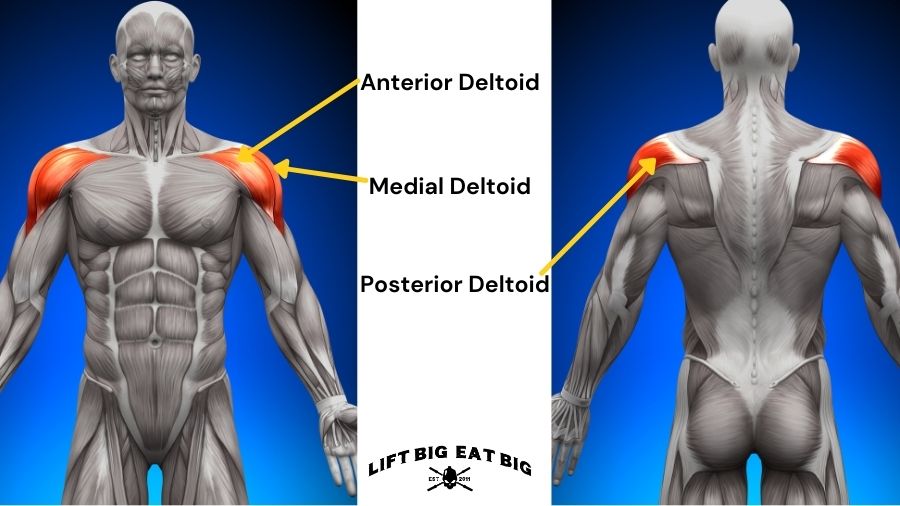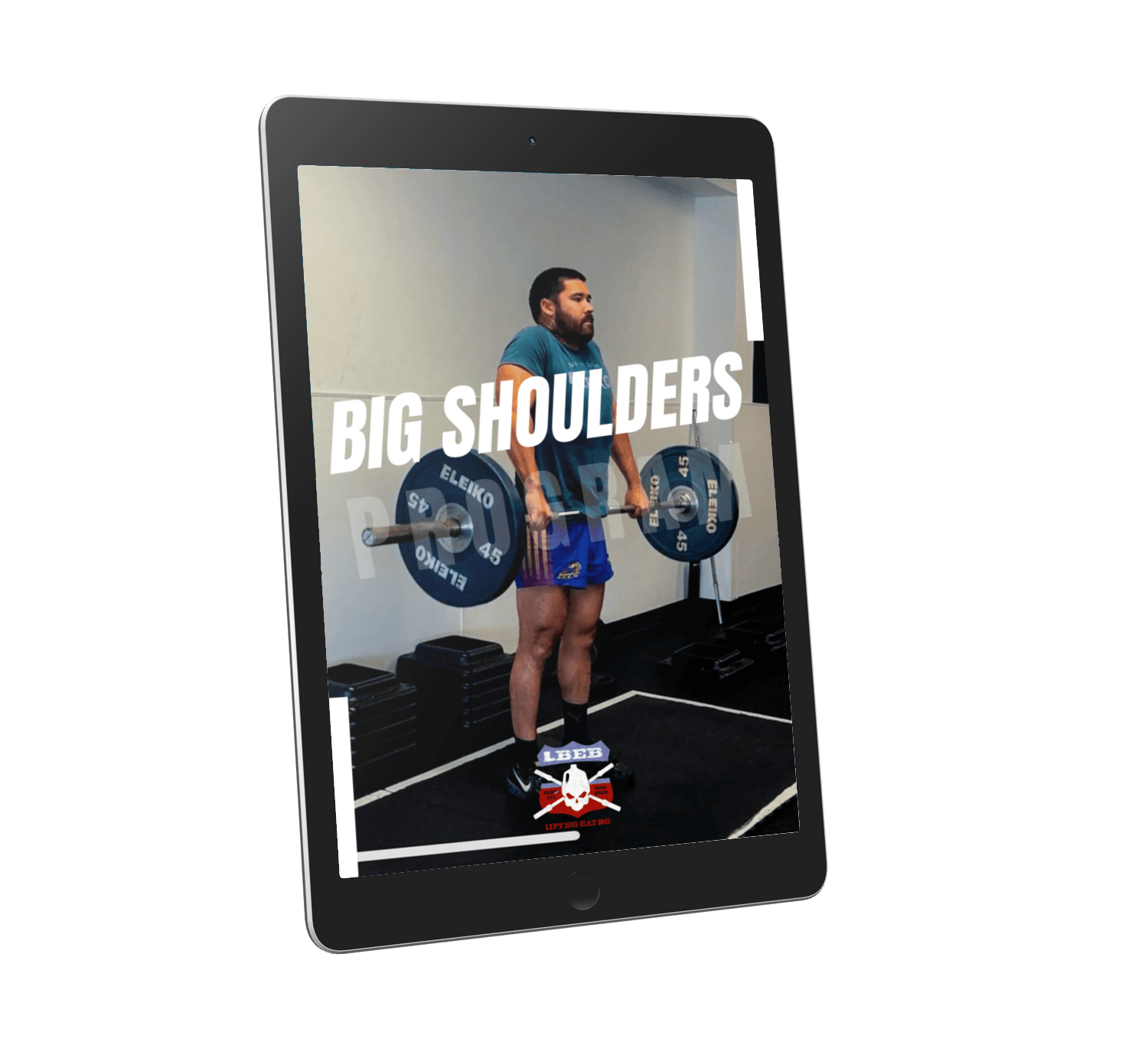The size of your shoulders will make or break your physique. You can have large arms, a massive chest, and a wide back, but if your shoulders aren't like their own planets on either side of your neck, you will still look small and weak.
To get bigger shoulders, you must train all three muscles of the shoulder: the front, side, and rear deltoids. Many lifters have overpowering front delts and undertrained side and rear delts, making focusing on the side and rear delts most important for big shoulders.
Maximizing the size of the shoulders requires understanding basic anatomy so you can adequately target each muscle head.
Table of Contents
Anatomy Of The Shoulder
To maximize the size of the shoulders, you need to target all three muscles. These are:
- Anterior deltoid (front)
- Medial deltoid (side)
- Posterior deltoid (rear)

Each muscle supports a different movement of the shoulder. The anterior or front deltoid is primarily responsible for shoulder flexion and horizontal adduction. That is raising your arm in front of you (e.g., front raise) and performing a chest fly motion [1,2].
The side delts are responsible for shoulder abduction, which is the arm raised to the body's side [1]. This muscle creates a broader look of the upper body. The rear deltoid provides a 3D look and will make your physique pop when looking from the side. Rear delts are responsible for shoulder extension and horizontal abduction [1].
3 Powerful Tips To Get Bigger Shoulders
You can listen to our Lift Big Eat Big podcast above as we discuss everything building huge shoulders from our experiences!
Focus On The Side And Rear Delts
The front delts get a lot of love. They are easy to train since you can see them in the mirror, and they are hit during every pressing exercise. So, if you have separate chest and shoulder days, all pressing you do targets the front delts.
But well rounded, large shoulders are determined by the side and rear delts. These two muscles will provide a complete, 3D look and add width to your physique. A great rule to follow is to start your shoulder or pressing day with rear delt work.
It won't hamper your pressing sets and acts as an excellent shoulder warm-up. Follow that by a pressing exercise and then hammer the side delts, and you've got a great shoulder workout.
Train With Adequate Volume
There is a dose-response relationship between training volume and building muscle. That is, the more sets and reps you perform, the greater the muscle growth [3]. We are looking at a minimum of 7 sets per week up to approximately 25 sets per week for the shoulders.
Use A Specialization Program
The old-time strongmen often used body part specialization programs. It's a great way to blast a particular muscle group that is lagging as you focus all your efforts on it.
A shoulder specialization program would have you training the shoulders directly 2-3 times per week while performing minimal volumes of training for the other muscle groups.
5 Best Exercises For Bigger Shoulders
Overhead Press
The overhead press is also known as the press, military press, or shoulder press and is a staple exercise for big shoulders. The front and side delts are the main shoulder muscles worked during the overhead press [4] and elicit the highest front delt activation among compound exercises [1].
Often you won’t find this exercise within a typical bodybuilding program. You may find seated variations as the load is lighter and targeted to your shoulders. But overall, bodybuilders prefer isolation exercises that target certain heads of the shoulder and don’t cause as much fatigue.
Here’s how to do the overhead press:
Recommended sets and reps: 3-5 sets of 5-10 reps
Front Raise
Powerful front delts will power up the size of your shoulders and your pressing strength. Since the front delts are heavily recruited when bench pressing, bigger and stronger front delts can help you press more weight.
Safe to say, the average lifting enthusiast probably doesn’t need to perform front raises. The vast amount of pressing within a typical training program is more than enough to stimulate and grow the front delts.
But if you can't overhead press due to injury or want to add more front delt volume, you can add the front raise to isolate the front delts.
You’re not limited to using dumbbells. EZ bars, barbells, kettlebells, and even sandbags are great equipment options. Here’s how to get the most from the front raise:
Simple as that. You can be seated to minimize any body momentum to make them more difficult.
Recommended sets and reps: 3-5 x 10-20
Dumbbell Lateral Raise
The staple side delt exercise is the lateral raise. I would consider this the best side delt exercise you can do.
It loads the exact movement the side delts are responsible for, backed by the research showing lateral raises eliciting the most significant activation of the side delts [1].
Every shoulder workout routine should have a lateral raise variation in it. The side delts will build a wide physique that will be missing if you are not training them directly. Unfortunately, while the overhead press does activate the side delts, it is not enough to create that round shoulder shape.
Here is how to do the perfect lateral raise:
One big mistake is focusing on the hands above the elbows when lateral raising. This won’t give you the same feeling. You can also do these with cables to hit the side delts from a different angle.
Recommended sets and reps: 3-5 x 10-20
Reverse Pec Deck
In my experience, the reverse pec deck is the best rear delt exercise you can do. Because it’s a machine, you don’t need to worry about gripping dumbbells or fatiguing when bending over during high rep sets.
Further, you can truly isolate the rear delts and focus on the mind-muscle connection. The reverse pec deck satisfies the exact movement the rear delts are responsible for. So much so that the reverse pec deck elicits the most significant rear delt muscle activation compared to rowing variations [5].
Here’s how to get the most out of the reverse pec deck:
There are a few technical considerations to be aware of. Firstly, don't hold the handles on the machine as it makes it difficult to relax the forearms. Further, this position isn't as good for activating the rear delts as the palms-down position.
Secondly, you shouldn’t intentionally move the shoulder blades like other reverse fly movements. Everything should be solely focused on the rear delts performing the work. Which means you can’t pull the handles past your body.
Recommended sets and reps: 3-5 x 15-20
Bent-Over Reverse Fly
This is the next best exercise if you don’t have access to a reverse pec deck. You can mimic a similar motion when bent over parallel to the floor by holding dumbbells. To reduce the involvement of larger muscles like the rhomboids and traps, treat the reverse fly like a relaxed swinging motion.
Here’s how:
Your shoulder blades should be left as still as possible with only the arms moving. This will isolate the rear delts and reduce the involvement of the mid traps and rhomboids. It will feel like a swinging motion which is perfectly fine.
Recommended sets and reps: 3-5 x 15-20
Scientific Shoulder Workout Routine For Mass
Exercise | Set/Rep | Load |
|---|---|---|
A1) Reverse Pec Deck | 5 x 20 | 9 RPE |
B1) Barbell Overhead Press or Machine Press | 5 x 8-10 | 8 RPE |
C1) DB Lateral Raise | 4 x 15 | 9 RPE |
D1) Prone Y Raise | 3 x 12 | 9 RPE |
D2) EZ Bar Upright Row | 3 x 10 | 9 RPE |
Shoulder Workout Routine At Home
If you’re training at home, you may not have access to equipment like barbells and power racks. So here is a workout that takes advantage of having minimal equipment.
Exercise | Set/Rep | Load |
|---|---|---|
A1) Band Pull Apart | 4 x 20 | 9 RPE |
B1) Bent Over DB Reverse Fly | 4 x 15 | 9 RPE |
C1) Handstand Push-Up | 5 x 5-10 | 9 RPE |
D1) DB Lateral Raise | 4 x 15 | 10 RPE |
E1) DB Front Raise | 3 x 12 | 9 RPE |
Shoulder Workout Routine With Dumbbells
Only have dumbbells? Try this dumbbell-only shoulder workout.
Exercise | Set/Rep | Load |
|---|---|---|
A1) Bent Over DB Reverse Fly | 4 x 20 | 9 RPE |
B1) DB Front Raise | 4 x 12 | 9 RPE |
C1) DB Lateral Raise | 4 x 15 | 9 RPE |
D1) DB Overhead Press | 4 x 8-10 | 10 RPE |
Shoulder Workout Routine No Pressing
Some lifters may have previous injuries that prevent them from pressing overhead. Here is a giant set you can perform for an epic shoulder pump.
Exercise | Set/Rep | Load |
|---|---|---|
A1) Dumbbell Reverse Fly | 5 x 20 | 9 RPE |
A2) Lateral Raise | 5 x 15 | 9 RPE |
A3) Dumbbell Front Raise | 5 x 15 | 9 RPE |
D1) DB Overhead Press | 4 x 8-10 | 10 RPE |
Shoulder Workout Without Weights
Have nothing at home? No problem, give this shoulder workout without weights a try!
Exercise | Set/Rep | Load |
|---|---|---|
A1) TRX Reverse Fly | 5 x 15-20 | 10 RPE |
B1) Handstand Push-Up | 5 x 5-10 | 10 RPE |
Summary
Developing bigger shoulders is challenging, especially since three muscle heads need isolating. Most lifters struggle to activate the rear delts, immensely enhancing their physique. By doing rear delt exercises first in your workout, you can focus on them while you are fresh to develop a 3D look to your shoulders.
References
1. Campos, Y. A., Vianna, J. M., Guimarães, M. P., Oliveira, J. L., Hernández-Mosqueira, C., da Silva, S. F., & Marchetti, P. H. (2020). Different shoulder exercises affect the activation of deltoid portions in resistance-trained individuals. Journal of Human Kinetics, 75(1), 5-14.
2. Franke, A. R., Botton, C. E., Rodrigues, R., Pinto, R., & Lima, C. (2015). Analysis of anterior, middle, and posterior deltoid activation during single and multijoint exercises. J Sports Med Phys Fitness, 55, 714-721.
3. Schoenfeld, B. J., Ogborn, D., & Krieger, J. W. (2017). Dose-response relationship between weekly resistance training volume and increases in muscle mass: A systematic review and meta-analysis. Journal of sports sciences, 35(11), 1073-1082.
4. Kroell, J., & Mike, J. (2017). Exploring the standing barbell overhead press. Strength & Conditioning Journal, 39(6), 70-75.
5. Botton, C. E., Wilhelm, E. N., Ughini, C. C., Pinto, R. S., & Lima, C. S. (2013). ELECTROMYOGRAPHICAL ANALYSIS OF THE DELTOID BETWEEN DIFFERENT STRENGTH TRAINING EXERCISES. Medicina Sportiva, 17(2)5

